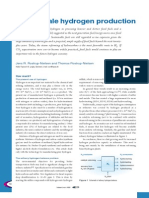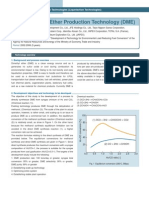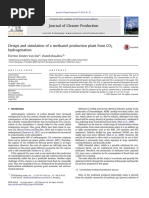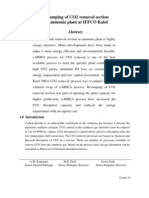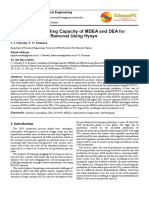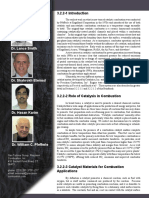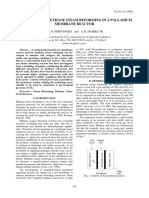10 1 1 566 3721
10 1 1 566 3721
Uploaded by
Ricardo ACCopyright:
Available Formats
10 1 1 566 3721
10 1 1 566 3721
Uploaded by
Ricardo ACOriginal Title
Copyright
Available Formats
Share this document
Did you find this document useful?
Is this content inappropriate?
Copyright:
Available Formats
10 1 1 566 3721
10 1 1 566 3721
Uploaded by
Ricardo ACCopyright:
Available Formats
Slurry Phase Synthesis and Utilization of Dimethyl Ether
Yotaro Ohno*, Norio Inoue**, Takashi Ogawa***,
Masami Ono***, Tsutomu Shikada**** and Hiromasa Hayashi*****
*
**
***
****
*****
Chief Engineer, Dr, Environmental Solution Center
Manager, Environmental Solution Center
Senior Research Engineer, Engineering Research Center
Chief Researcher, Dr, Applied Technology Research Center
Senior Research Engineer, Applied Technology Research Center
DME (dimethyl ether) has been attracting the attention of industry as a clean fuel for the 21st century. NKK has
been conducting original DME synthesis research since 1989. Operational research was performed in a 5 tons-DME
production/day pilot plant, which operated continuously under very stable conditions for periods up to two months.
These studies led to the successful synthesis of DME from methane directly from coal layers. Combustion tests of
DME in a commercial type household cooking gas stove and diesel truck driving tests confirmed that DME has high
potential as an alternative fuel.
1.
Economics and Industry). The technology was implemented jointly by the CCUJ (Center for Coal Utilization,
Japan), Taiheiyo Coal Mining Co., Ltd., and Sumitomo
Metal Industries, Ltd. at a plant constructed at the Taiheiyo Coal Mining site in Kushiro City. Construction began in the summer of 1999, and operation and research
commenced approximately 18 months later. A total of six
continuous trials have been conducted, and operation of
the plant has proven to be extremely stable, with the longest continuous period of operation being two months. A
total of approximately 400 tons of high-purity DME has
been produced during these trials.
Introduction
DME (Dimethyl ether) is a new, easily handled fuel that
is currently the subject of considerable interest. NKK began basic research and development on a new synthesizing
catalyst in 1989. Following completion of this work in
1995, NKK established a small-scale bench plant capable
of producing DME at a rate of 50 kg per day. In 1997 a
large-scale bench plant capable of producing approximately five tons per day was constructed to develop a new,
high-efficiency, DME synthesis process1).
DME is currently manufactured at a rate of approximately 10000 tons annually for such applications as cosmetics and aerosol paint propellants. This DME is produced using methanol as the raw material and involves a
dehydration reaction to remove a single water molecule
from two methanol molecules.
NKK developed new production technology that uses
carbon monoxide (CO) and hydrogen (H2) gases as the raw
material for synthesizing DME in a highly-efficient, single-step reaction process. The conversion efficiency for
the raw material gases for the synthesis reaction and the
selectivity level to the DME product are extremely high.
Thus, the synthesis process is more compact and simple
than that for the production of methanol from CO and H2.
The large-scale bench plant introduced in 1997 was a
technology development program supported by the Resources and Energy Agency within the Ministry of International Trade and Industry (now the Ministry of Trade,
2.
Characteristics of DME as a fuel
DME has similar properties to LPG in that it is a gas at
ambient temperature and atmospheric pressure. It becomes
a colorless clear liquid under six atmospheres at ambient
temperature or at atmospheric pressure and a temperature
of 251). Thus, DME can be transported and stored as a
liquid at low temperature in a similar manner to LPG.
DME is a clean fuel that contains no sulfur or nitrogen
compounds, has extremely low toxicity for humans, and
has no corrosive effect on metals. Its calorific value is approximately 65% that of methane (natural gas) and approximately 40% that of methanol. Although DME has a
lower calorific value than LPG because of differences in
the chemical structure, the density of liquid DME is
greater, so the total calorific value of a tank of DME is approximately 90% of that of a similar tank of LPG.
23
NKK TECHNICAL REVIEW No.85 (2001)
Slurry Phase Synthesis and Utilization of Dimethyl Ether
kcal per kilogram of DME). This reaction heat must be
removed efficiently from the reactor to maintain a stable
temperature and to allow stable control of the DME direct
synthesis reaction. NKK therefore developed a
high-pressure DME slurry bed reactor that has excellent
mixing characteristics and easy control of the reaction
temperature. This slurry bed reactor contains a high boiling point solvent (reaction medium) in which fine catalyst
particles are mixed. The gases that form the raw materials
of the reaction provide strong mixing of the catalyst. This
ensures good flow of the gases within the reactor, a very
even temperature distribution, and ready control of the
DME direct synthesis in the presence of the highly exothermic reaction.
The DME direct synthesis reaction is characterized by
NKKs proprietary highly active catalyst and the DME
slurry bed reactor technology, which controls the reaction
to extract the maximum performance from this catalyst.
When used as a replacement for diesel fuel, DME has a
high cetane value, contains oxygen, and has a chemical
structure that forms carbon-carbon bonds, so that its combustion is not accompanied by black smoke or soot. This
property has attracted considerable interest in DME as a
clean fuel.
DME may be used in the same domestic applications as
LPG, as well in an extremely wide range of industrial applications, such as a replacement for diesel fuel and for
high-efficiency power generation fuels (e.g. for gas turbine
powered generators). DME is also easily stored and transported.
3.
Features of DME direct synthesis technology
The technology for direct synthesis of DME developed
by NKK employs a single-step reaction to synthesize
DME from CO and H2 as shown in (1) below.
3CO + 3H2 CH3OCH3(DME) + CO2
(1)
4. Five tons per day large-scale bench plant
4.1 Process flow
This formula summarizes the DME direct synthesis reaction. In practice, the reactions shown in the formulae (2),
(3), and (4) below occur simultaneously.
2CO + 4H2 2CH3OH (methanol)
(2)
2CH3OH CH3OCH3 (DME) + H2O
(3)
H2O + CO H2 + CO2
(4)
The large-scale bench plant is shown in Photo 1. Process flow is shown in Fig.1.
The two molecules of methanol synthesized from CO
and H2 in formula (2) are dehydrated in formula (3) to
produce DME. The water produced in formula (3) is recycled as hydrogen in formula (4).
It is important to note that the hydrogen produced at the
completion of the direct synthesis reaction becomes raw
material for the reaction in step (2). In this way, a reaction
cycle is formed in which the three reactions consume the
by-products in each step. The by-products of the reactions
therefore accumulate only to a minimal extent, allowing an
extremely high conversion efficiency for the total reaction
formula (1).
Formula (1) becomes increasingly favorable with increasing pressure, so the reaction is conducted at a pressure of 3 to 7MPa and temperature of 250 to 280 (basic
reaction conditions are 5MPa and 260).
Formula (1) is a highly exothermic reaction that produces 58.8 kcal per mole of DME (approximately 1280
NKK TECHNICAL REVIEW No.85 (2001)
Photo 1
Five ton per day DME test plant
Off-gas
CBM
DME
O2
LP gas
CO, H2, CO2
Methanol
Syn-gas reformerCO2 absorberReactor
Fig.1
24
Distiller
Process flow for five ton per day DME test plant
Slurry Phase Synthesis and Utilization of Dimethyl Ether
This plant employs refined methane from coal layers or
simulated coal gas (produced from LPG in this plant) as a
raw material to efficiently produce DME in a single-step
reaction using a slurry bed reactor.
The process components are described below.
(1) Synthesis gas production system incorporating a reformer to produce CO and hydrogen from the coal bed
methane (or LPG)
(2) Reaction system for direct synthesis of DME
(3) Distillation system for refining the DME produced, and
separating and recovering the by-product CO2
(4) Product storage and utility equipment system.
Each unit is controlled from a central computer in the
control room.
The coal bed methane or LPG is burned in the
auto-thermal reformer in an atmosphere of pure oxygen to
produce CO and H2 in a ratio of 1:1 (H2/CO=1). The CO2
produced in the reformer and the CO2 produced as a
by-product of direct synthesis of DME are separated and
partially recycled back to the reformer for use as a raw
material for gas synthesis.
If an efficiency of 100% was possible for the reforming
and DME direct synthesis reactions, natural gas (methane)
could be used in the ideal synthesis process described in
formula (7).
Table 1
(6)
Overall process
2CH4 + O2 DME + H2O
(7)
Plant
operation [h]
Syn-gas
production [h]
DME
production [h]
Run.
Test period
100
1999/Sep.9Sep.23
270
207
200
Oct.9Nov.2
466
460
408
457
300
Nov.11Dec.2
492
488
400
2000/Jun.12Jul.9
700
652
464
500
Jul.18Aug.6
495
484
458
600
Sep.18Dec.6
1870
1780
1650
4293
4071
3437
Sum.
Run 200 was the first in which DME was produced. The
entire plant was started, and various tests were conducted
on all systems.
Run 600 involved continuous and stable operation of the
plant for a period of two months. Approximately 400 tons
of DME was produced during Run 200 through Run 600.
4.3 Results of operation and research
4.3.1 Outline of results
All systems in the plant operated in a stable manner
during Run 200 through Run 600, and a detailed process
mass-balance data was recorded for further analysis. The
primary operation and research results are as follows.
(1) A per-pass synthesis gas conversion of higher than
50% and a product DME selectivity of higher than 90%
were achieved in the direct synthesis of DME.
(2) A total synthesis gas conversion of at least 95% was
achieved.
(3) The purity of the DME produced was at least 99.5%.
(4) The successful direct synthesis of DME from 100%
coal bed methane was a world first.
(5) The daily production was attained up to 5.7 tons while
the plant was designed for a daily production of 5 tons.
(6) A stable operation of the reaction system was maintained for 1650 hours (the plant operated for 1870 hours in
total).
(7) Data was recorded for use in scaling-up the DME
slurry bed reactor.
4.3.2 Plant material balance and product selectivity
The mass-balance data (materials used, product) for a
representative plant producing 5.7 tons of DME per day is
shown in Table 2. The process consists of partial oxidation with pure oxygen to synthesize gas at a ratio of
H2/CO=1 using LPG as the primary raw material and CO2
and steam as the secondary raw materials. Production was
approximately 5.7 tons of DME per day and 0.6 tons of
methanol per day from the synthesis gas. The CO and H2
in Table 2 are un-reacted gases included in the gas purged
Reformer
2CH4 + CO2 + O2 3CO + 3H2 + H2O (5)
DME synthesis
3CO + 3H2 CH3OCH3(DME) + CO2
Continuous plant operation details
4.2 Operation and research
Operation and research of the large-scale bench plant
commenced in September 1999 and continued until December 2000. The objective of the work was to establish
technology for a high-performance DME synthesis process
under the long-term and stable operation of a large-scale
plant, to obtain detailed data for use in scaling-up the
process, and to produce large volumes of DME. The plant
was run continuously six times (Run Nos. 100 to 600).
Details are shown in Table 1.
Run 100 was conducted solely to test the gas synthesis
system. The reaction and distillation systems were tested
without producing DME.
25
NKK TECHNICAL REVIEW No.85 (2001)
Slurry Phase Synthesis and Utilization of Dimethyl Ether
4.3.3 Total conversion of synthesis gas
Between 40 and 50% of the raw material gas is converted to DME after passing through the reactor (the
once-through conversion varies with the operating conditions). As shown in the process flow diagram, the
un-reacted raw material gas discharged from the reactor
passes through the recycling compressor before being recirculated to the reactor. The amount of this un-reacted
gas that is recycled depends upon the conversion efficiency of the reaction process and affects such factors as
the scale of the equipment (e.g., the compressor size), the
operating costs of the equipment, and the final cost of
production.
As DME direct synthesis has a very high once-through
conversion level in comparison to methanol synthesis, the
volume of un-reacted, recycled gas is small, permitting a
plant of compact design. Fig.2 shows the effect of the recycling ratio, i.e., the ratio of the un-reacted, recycled gas
volume to the volume of synthesized gas introduced into
the reactor system (make-up gas). The total conversion of
CO in the make-up synthesized gas as calculated from
measured data is also shown. Fig.2 indicates that the total
CO conversion exceeds 95% at a recycling ratio of approximately 1.7, and that the once-through CO conversion
maintains a relatively constant value.
The process is commercially viable provided the gas
recycling system is designed to handle recycling of a
volume of gas approximately twice the volume of the synthesized make-up gas. Under the same reaction conditions,
the process is considerably more compact than the methanol synthesis process.
from the reactor system as off gas. The total CO conversion was 94%.
Table 2
Materials balance in LPG plant operation
Raw
material
Flow rate
[Nm3/h]
LP gas
CO2
Product
Flow rate
[kg/h]
Production
[t/d]
124.1
DME
238.2
5.72
66.8
MeOH
26.3
0.63
Steam
241.9
water
3.7
0.09
O2
85.9
CO2
111.4
CO
22.9
H2
15.9
Total CO conversion
94.0 [%]
The ratio of hydrogen atoms to carbon atoms in propane
(C3H8), which is the primary component of the LPG raw
material, is less than that for methane (CH4), so all of the
CO2 produced as a by-product of DME synthesis cannot be
reconverted in the reformer. However, approximately 60%
of the 111Nm3/hr of CO2 generated is reused as a secondary raw material in the production of synthesis gas.
The product selectivity is shown in Table 3. A feature
of this DME direct synthesis method is that it has a very
high once-through conversion synthesis gas, along with a
DME product selectivity of higher than 90%. In addition to
the CO2 and methanol produced, the only other by-product of
the process is a very small amount of methane.
The process produces no by-products such as heavy oils
and not even trace quantities of toxic materials. These
characteristics eliminate the need for complex separation
and refining of generated products and guarantee a simple
synthesis process, leading to reduced plant costs and operating expenses.
The CO2 produced as a by-product when natural gas
(methane) is used as the primary raw material is recirculated to the reformer. The methanol produced has value as
a product, but it is recycled to the reactor and may be finally converted to DME because it is an intermediate
product of the DME synthesis reaction. The DME product
selectivity shown in Table 3 is the carbon selectivity to
DME without CO2 and DME contained in recovered
methanol.
Table 3
1.0
Total CO conversion , %
0.8
Selectivity [C-mol%]
DME
CO2
MeOH
DME product
selectivity [C-mol%]
LPG100%
64.7
33.8
1.6
97.6
CBM85% + LPG15
64.8
32.4
2.8
95.8
CBM100%
63.4
30.9
5.7
91.8
0.0
0.8
1.0
1.2
1.4
1.6
1.8
2.0
Gas recycle ratio , -
Fig.2
(CBM = Coal bed methane)
NKK TECHNICAL REVIEW No.85 (2001)
0.4
0.2
Product selectivity (once-through basis)
Raw material
Total CO conversion
Per-pass CO conversion
0.6
26
Total CO conversion as a function of recycling ratio
Slurry Phase Synthesis and Utilization of Dimethyl Ether
5. DME utilization technology
5.1 Use as an LPG alternative
DME is already used as an aerosol propellant, and it is
expected that, in the future, it will also be used in such applications as fuel for power generation, diesel vehicles,
and consumer applications, as a raw material for chemical
processes, and as a cooling medium2-4). The prospect of
DME as an alternative fuel to LPG in consumer applications stimulated experiments to investigate DME combustion in existing mass-produced combustion equipment in
order to gain an understanding of its combustion characteristics.
DME has a WI (Wobbe Index, which is the higher calorific value/(specific gravity)1/2 and is used as a basic
measure of heat input for gas appliances) of 51.91 MJ/Nm3
and an MCP (an index of the rate of gas combustion) of 48
to 50. The WI for DME is close to that of 13A and 12A
municipal gases, but its MCP is outside the corresponding
range. DME is equivalent to a gas classification of 12C, a
type not currently used.
Combustion tests of DME were conducted using standard domestic cooking stoves designed for LPG or municipal gas 13A. Combustion of DME using the LPG stove
shown in Photo 2(a) is clearly unsatisfactory. No significant improvement in combustion was observed, even when
the air adjustment damper, which is normally fixed, was
closed down to approximately 80%. This lack of improvement is due to the fact that the diameter of the main
nozzle on the LPG stove is very small (0.9 mm), thus preventing a sufficient supply of DME and resulting in insufficient heat of combustion.
Combustion of DME with the municipal gas 13A stove
is shown in Photo 2 (b). Combustion was relatively
satisfactory, but the flame tended to be shorter than is the
case when 13A is burned. Changing the opening of the
variable air adjustment damper from 8/10 to 5/10 reduced
the primary air supply and resulted in good combustion, as
shown in Photo 2(c). Changing the gas pressure from 1 to
3.3 kPa did not result in any significant difference in
combustion.
JIS combustion testing (JIS S 2093) to determine the
suitability of the gas combustion equipment for DME resulted in passes in all items on the test schedule, from tests
in no-wind conditions to tests with large pots, and certification was granted (see Table 4). JIS thermal efficiency
testing (JIS S 2093) to determine the performance of gas
combustion equipment in use showed a thermal efficiency
(a) LPG specification, damper opening : fixed
(b) 13A specification, damper opening : 8/10
(c) 13A specification, damper opening : 5/10
Photo 2
Combustibility of DME
of 47.9% with DME, approximately 2% less than with
municipal gas 13A. DME is well within the JIS standards,
which require a thermal efficiency of at least 40%.
Table 4
DME combustion test results
Item
Test under
windless
condition
JIS standard
Result
Ignition
No explosiveignition
None
Flame stability
Steady flame
Passed the standard
Back fire
No back fire
None
Combustion noise
60 dB or less
Within the standard
Fire extinguish
No explosive noise
Within the standard
CO concentration
0.14% or less
0.05
Soot emission
No emission of soot
Within the standard
Oversized pot test
Total evaluation
Steady flame / no odor
Passed the standard
Passed the standard
Conditions : Japanese municipal gas 13A specifications. damper opening 5/10
5.2 Use as a diesel fuel alternative
DME has the same or higher cetane value as diesel fuel
and is therefore ideal for use in diesel engines. However,
modifications to the fuel supply system are required because both the boiling point and viscosity of DME are less
than those of diesel fuel.
27
NKK TECHNICAL REVIEW No.85 (2001)
Slurry Phase Synthesis and Utilization of Dimethyl Ether
hicles. It is therefore hoped that the use of such vehicles
will become widespread in the near future.
Smoke Bosch , %
14
Diesel
30
12
DME
25
10
NOx
20
15
10
Smoke
0
105
BSFC , MJ/kWh
35
NOISE
30
100
25
95
20
90
85
15
BSFC
10
80
75
7
15
22
29
37
44
Power , kW
Fig.3
DME and diesel fuel performance comparison
(at 2000rpm)
References
1) Ogawa, T. et al. NKK Technical Review, No.81, pp.1317(1999).
2) Fleisch, T. et al. SAE Paper, 950061 (1995).
3) Sorenson, S. C. et al. SAE Paper 950064 (1995).
4) Ikizawa, et al. Motor Vehicle Technology Conference, Autumn Lectures, 13 (1998).
5) Jidousha Kougaku, July 2001, pp.6073.
<Please refer to>
Yotaro Ohno
Environmental Solution Center
Tel. 03 (3217) 3266
E-mail address : Yotaro_Ohno@ntsgw.Tokyo.nkk.co.jp
Takashi Ogawa
Engineering Research Center
Tel. 044 (322) 6241
E-mail address : Takashi_Ogawa@ntsgw.Tokyo.nkk.co.jp
Photo 3
DME diesel truck
An oxidation catalyst is sufficient for purifying the exhaust gas because the engine does not emit black exhaust
smoke, and the CO and HC emissions are greatly reduced.
The modifications to a diesel engine to permit the use of
DME are minimal, consisting only of changes to the fuel
supply system. With these minimal changes, the highly
energy-efficient diesel engine may be converted to a relatively clean-burning engine, providing an effective method
to resolve the environmental problems posed by diesel veNKK TECHNICAL REVIEW No.85 (2001)
NOx , g/kWh
35
NOISE , dB(A)
NKK employed its diesel engine test bench, which has
been in use since 1997, to investigate both the characteristics of DME when used in diesel engines and the fuel supply system required for this application. In 1998, a light
truck was operated on DME, which was a world first4).
A description of the modifications of diesel engines to
use DME and the associated combustion characteristics are
presented below.
The use of DME, with its low boiling point and low
viscosity, does not require modifications to the diesel engine itself. Nevertheless, in contrast to diesel fuel, DME
must be supplied to the fuel injection pump under pressure.
In initial experiments, gas pressure from a nitrogen bottle
was used for pressurization, but this installation resulted in
supply equipment of considerable size, and nitrogen gas
dissolved into the liquid DME. A small fuel supply pump
was therefore developed5) to overcome these problems.
The DME diesel truck employed in the experiment is
shown in Photo 3. The original diesel fuel tank was used
to contain the DME.
As shown in Fig.3, the combustion characteristics of the
DME diesel engine include a thermal efficiency that is
similar to that of diesel, but without soot emission and
with greatly reduced NOx emissions and noise levels. This
is due to the fact that DME is an oxygenated fuel without
carbon bonding and to the greater ignitability in comparison to diesel.
28
You might also like
- Design Project (1) FinalDocument38 pagesDesign Project (1) FinalJasonNtsako100% (3)
- Acetic Acid Plant DesignDocument8 pagesAcetic Acid Plant DesignMir Hasib Ul Latif50% (6)
- Methanol Plant Process Description LurgiDocument6 pagesMethanol Plant Process Description LurgiGaukharAlzhanova0% (1)
- CPE603 Assignment ASPEN HYSYS Simulation PDFDocument49 pagesCPE603 Assignment ASPEN HYSYS Simulation PDFDiego CoronaNo ratings yet
- Large-Scale Hydrogen ProductionDocument10 pagesLarge-Scale Hydrogen ProductionJulio DutraNo ratings yet
- Transshipment LP Model For Minimizing The Utility Cost in A Heat Exchanger NetworkDocument7 pagesTransshipment LP Model For Minimizing The Utility Cost in A Heat Exchanger NetworkRicardo ACNo ratings yet
- New Direct Synthesis Technology For DME (Dimethyl Ether) and Its Application TechnologyDocument7 pagesNew Direct Synthesis Technology For DME (Dimethyl Ether) and Its Application TechnologyYiğit IlgazNo ratings yet
- 2010 HosseininejadDocument14 pages2010 HosseininejadLeonard SaftaNo ratings yet
- Direct Dimethyl Ether SynthesisDocument9 pagesDirect Dimethyl Ether SynthesissltnrmnNo ratings yet
- Slurry Phase Reactor Technology For DME Direct SynthesisDocument13 pagesSlurry Phase Reactor Technology For DME Direct SynthesischusnuhNo ratings yet
- Slide 1: 1) Transportation Fuel: DME Is An Excellent and Very Efficient Alternative FuelDocument8 pagesSlide 1: 1) Transportation Fuel: DME Is An Excellent and Very Efficient Alternative FuelNeha MadanNo ratings yet
- 4A4. Dimethyl Ether Production Technology (DME) : Multi-Purpose Coal Utilization Technologies (Liquefaction Technologies)Document2 pages4A4. Dimethyl Ether Production Technology (DME) : Multi-Purpose Coal Utilization Technologies (Liquefaction Technologies)M Usman ChaudhryNo ratings yet
- Biomass To Dimethyl Ether by Gasi Fication/synthesis Technology - An Alternative Biofuel Production RouteDocument10 pagesBiomass To Dimethyl Ether by Gasi Fication/synthesis Technology - An Alternative Biofuel Production Routedavid.buentelloNo ratings yet
- Lurgi MTP ArticleDocument10 pagesLurgi MTP Articlerkhandelwal9604100% (1)
- Methanol Production by CO Hydrogenation: Analysis and Simulation of Reactor PerformanceDocument19 pagesMethanol Production by CO Hydrogenation: Analysis and Simulation of Reactor PerformancehelloNo ratings yet
- Literature Review: 1.1 PropertiesDocument6 pagesLiterature Review: 1.1 PropertiesPhilani MkhonzaNo ratings yet
- Design Summary: Technology IntroductionDocument6 pagesDesign Summary: Technology Introductionlux0008No ratings yet
- Experimental Study of Improved Two Step Synthesis For DME ProductionDocument6 pagesExperimental Study of Improved Two Step Synthesis For DME Productionmoman_1031No ratings yet
- Lurgi's Gas To ChemicalsDocument10 pagesLurgi's Gas To Chemicalslhphong021191No ratings yet
- Masaki IijimaDocument9 pagesMasaki IijimaNathan MoralesNo ratings yet
- DME Synthesis Technology Ready For Market: © Gastech 2005Document6 pagesDME Synthesis Technology Ready For Market: © Gastech 2005yan energiaNo ratings yet
- APE - Group 1 Methanol ProductionDocument5 pagesAPE - Group 1 Methanol ProductionNeeravNo ratings yet
- Acetic AcidDocument19 pagesAcetic AcidEmre KOÇNo ratings yet
- Design and Simulation of A Methanol Production Plant From CO2 HydrogenationDocument8 pagesDesign and Simulation of A Methanol Production Plant From CO2 HydrogenationJJ100% (1)
- Methanol Production From Natural Gas Reforming and CO2 CapturingDocument12 pagesMethanol Production From Natural Gas Reforming and CO2 Capturingguigoal2010No ratings yet
- Multiobjective Optimization of Methanol Synthesis Loop From Synthesis Gas Via A Multibed Adiabatic Reactor With Additional Interstage CO2 QuenchingDocument9 pagesMultiobjective Optimization of Methanol Synthesis Loop From Synthesis Gas Via A Multibed Adiabatic Reactor With Additional Interstage CO2 QuenchingSarang GohNo ratings yet
- Direct Synthesis TechnologyDocument7 pagesDirect Synthesis TechnologyM Alim Ur RahmanNo ratings yet
- Chanchal Dmepetrofedpaper2014Document7 pagesChanchal Dmepetrofedpaper2014Luis Miguel Silva FernandezNo ratings yet
- 1 s2.0 S0016236122028514 MainDocument10 pages1 s2.0 S0016236122028514 Mainharibhai7882No ratings yet
- Multiobjective Optimization of Methanol Synthesis Loop From Synthesis Gas Via A Multibed Adiabatic Reactor With Additional Interstage CO2 QuenchingDocument9 pagesMultiobjective Optimization of Methanol Synthesis Loop From Synthesis Gas Via A Multibed Adiabatic Reactor With Additional Interstage CO2 QuenchingElnovista NababanNo ratings yet
- Simulation of Methanol Production From Synthesis Gas: KeywordsDocument14 pagesSimulation of Methanol Production From Synthesis Gas: KeywordsJiawen ChongNo ratings yet
- Towards Full One-Pass Conversion of Carbon Dioxide To Methanol and Methanol-Derived ProductsDocument5 pagesTowards Full One-Pass Conversion of Carbon Dioxide To Methanol and Methanol-Derived ProductsHUGO EMILIO GUAJARDO TERANNo ratings yet
- Synthetic Fuel Production by Indirect Coal LiquefactionDocument24 pagesSynthetic Fuel Production by Indirect Coal Liquefactionlux0008No ratings yet
- DME From Syngas JapanDocument4 pagesDME From Syngas JapaneniNo ratings yet
- Sustainability 12 08524Document13 pagesSustainability 12 08524Ainul YaqinNo ratings yet
- Produccion de MetanolDocument13 pagesProduccion de MetanolJosué Genaro García DuqueNo ratings yet
- Comparison of Different CO Recovery Processes in Their Optimum Operating Conditions FromDocument6 pagesComparison of Different CO Recovery Processes in Their Optimum Operating Conditions FromFunky labsNo ratings yet
- He 2016Document9 pagesHe 2016RONALD ALEX CHATA YAURINo ratings yet
- 2 2 2 Raphael Idem, Malcolm Wilson, Paitoon Tontiwachwuthikul, Amit Chakma, Amornvadee Veawab, Adisorn Aroonwilas, and Don GelowitzDocument7 pages2 2 2 Raphael Idem, Malcolm Wilson, Paitoon Tontiwachwuthikul, Amit Chakma, Amornvadee Veawab, Adisorn Aroonwilas, and Don GelowitznakurawNo ratings yet
- Be 20220602 14Document7 pagesBe 20220602 14Nipun ChopraNo ratings yet
- Major Unit DesignDocument32 pagesMajor Unit DesignFunmilayo Salaja Fatokun0% (1)
- Energy Efficient Solvents For CO Absorption From Flue Gas: Vapor Liquid Equilibrium and Pilot Plant StudyDocument26 pagesEnergy Efficient Solvents For CO Absorption From Flue Gas: Vapor Liquid Equilibrium and Pilot Plant StudyEr Mayur PatilNo ratings yet
- Co 2 RevspDocument7 pagesCo 2 RevspNeima DoualehNo ratings yet
- Nano AssmntDocument6 pagesNano AssmnteisaNo ratings yet
- EnergyDocument23 pagesEnergydilip matalNo ratings yet
- Production of Methanol From GlycerolDocument64 pagesProduction of Methanol From GlycerolHafizuddin AdzharNo ratings yet
- A Novel Polygeneration Process To Co-Produce Ethylene and Electricity From Shale Gas With Zero CO2 Emissions Via Methane Oxidative CouplingDocument15 pagesA Novel Polygeneration Process To Co-Produce Ethylene and Electricity From Shale Gas With Zero CO2 Emissions Via Methane Oxidative CouplingEdwinAndresRodriguezNo ratings yet
- CO Abatement Through A Methanol Production Process: C H E M I C A L E N G I N E E R I N G T R A N S A C T I O N SDocument6 pagesCO Abatement Through A Methanol Production Process: C H E M I C A L E N G I N E E R I N G T R A N S A C T I O N SShahrizatSmailKassimNo ratings yet
- Simulation of Processes For Efficient Methanol Production Using Co and Solar EnergyDocument6 pagesSimulation of Processes For Efficient Methanol Production Using Co and Solar EnergyaitormrNo ratings yet
- CO2 Capture Optimization Using RSMDocument11 pagesCO2 Capture Optimization Using RSMiitgn007100% (1)
- Simulation Co2 Removal Unit of Natural Gas by Aspen-HysysDocument5 pagesSimulation Co2 Removal Unit of Natural Gas by Aspen-HysysxinghustNo ratings yet
- A-Review-on-Synthesis-of-Dimethyl-Ether-from-Syngas-Over-Bifunctional-Hybrid-CatalystsDocument24 pagesA-Review-on-Synthesis-of-Dimethyl-Ether-from-Syngas-Over-Bifunctional-Hybrid-Catalystsmariochiau03No ratings yet
- (Polish Journal of Chemical Technology) Process Simulation of Dimethyl Ether Synthesis Via Methanol Vapor Phase DehydrationDocument6 pages(Polish Journal of Chemical Technology) Process Simulation of Dimethyl Ether Synthesis Via Methanol Vapor Phase DehydrationKaramYassNo ratings yet
- A Novel Route For Converting Aromatics Into Hydrogen Via Steam ReformingDocument8 pagesA Novel Route For Converting Aromatics Into Hydrogen Via Steam ReformingMarcelo Varejão CasarinNo ratings yet
- Global Kinetics of Direct Dimethyl Ether Synthesis Process From Syngas in Slurry Reactor Over A Novel Cu ZN Al ZR Slurry CatalystDocument7 pagesGlobal Kinetics of Direct Dimethyl Ether Synthesis Process From Syngas in Slurry Reactor Over A Novel Cu ZN Al ZR Slurry Catalystkrishna_nimeshNo ratings yet
- Simulation of Methanol Synthesis in Packed Bed Reactor Based On Gas From Biomass GasificationDocument9 pagesSimulation of Methanol Synthesis in Packed Bed Reactor Based On Gas From Biomass GasificationHaris Surya HidayatNo ratings yet
- Praxair CO2EmissionsReductionCapture WhitepaperDocument10 pagesPraxair CO2EmissionsReductionCapture WhitepaperBryan SaliNo ratings yet
- A New Power, Methanol, and DME Polygeneration Process Using Integrated Chemical Looping SystemsDocument15 pagesA New Power, Methanol, and DME Polygeneration Process Using Integrated Chemical Looping SystemsCriveanuNNarcisNo ratings yet
- Date of Submission: 5 MAY 2022Document11 pagesDate of Submission: 5 MAY 2022RUANGLADDA LIMPONGSAWATNo ratings yet
- Simulation of Loading Capacity of MDEA and DEA For Amine-Based CO Removal Using HysysDocument6 pagesSimulation of Loading Capacity of MDEA and DEA For Amine-Based CO Removal Using HysysZack AmerNo ratings yet
- Hydrogen Production TechnologiesFrom EverandHydrogen Production TechnologiesMehmet SankirNo ratings yet
- Clean Ironmaking and Steelmaking Processes: Efficient Technologies for Greenhouse Emissions AbatementFrom EverandClean Ironmaking and Steelmaking Processes: Efficient Technologies for Greenhouse Emissions AbatementNo ratings yet
- Chapter 8 Flow in Conduits: Entrance and Developed FlowsDocument43 pagesChapter 8 Flow in Conduits: Entrance and Developed FlowsRicardo ACNo ratings yet
- Extra Ea PIV AnnuRev FluidMech 120710 101204Document30 pagesExtra Ea PIV AnnuRev FluidMech 120710 101204Ricardo ACNo ratings yet
- Crimaldi EIF 2001Document13 pagesCrimaldi EIF 2001Ricardo ACNo ratings yet
- The Time Derivative: Direct Numerical Simulations of Multiphase Flows-3Document5 pagesThe Time Derivative: Direct Numerical Simulations of Multiphase Flows-3Ricardo ACNo ratings yet
- Liquid Film Disintegration Regimes and Proposed Correlations: I.S. Carvalho, M.V. Heitoyr, D. SantosDocument17 pagesLiquid Film Disintegration Regimes and Proposed Correlations: I.S. Carvalho, M.V. Heitoyr, D. SantosRicardo ACNo ratings yet
- Computers and Chemical EngineeringDocument11 pagesComputers and Chemical EngineeringRicardo ACNo ratings yet
- GPROMS InstallationDocument2 pagesGPROMS InstallationRicardo ACNo ratings yet
- Campus MapDocument3 pagesCampus MapRicardo ACNo ratings yet
- Secondary ManufactureDocument23 pagesSecondary ManufactureRicardo ACNo ratings yet
- Pre Sessional 2015Document3 pagesPre Sessional 2015Ricardo ACNo ratings yet
- QS World University Rankings by Subject 2014 - Engineering - ChemicalDocument2 pagesQS World University Rankings by Subject 2014 - Engineering - ChemicalRicardo ACNo ratings yet
- Chem Class 11 Notes For HydrogenDocument8 pagesChem Class 11 Notes For HydrogenAishahNo ratings yet
- (Rapra Review Reports) Tukker, Arnold-Plastics Waste - Feestock Recycling, Chemical Recycling and Incineration-iSmithers Rapra Publishing (2002-01-01) PDFDocument136 pages(Rapra Review Reports) Tukker, Arnold-Plastics Waste - Feestock Recycling, Chemical Recycling and Incineration-iSmithers Rapra Publishing (2002-01-01) PDFbaskoro7No ratings yet
- Olio PDFDocument6 pagesOlio PDFAlessia IaccarinoNo ratings yet
- Ammonia Process For FutureDocument5 pagesAmmonia Process For FutureSARFRAZ ALINo ratings yet
- RajatDocument25 pagesRajatrajatNo ratings yet
- Simulation of Methanol Production From Biomass Gasification in Interconnected Fluidized BedsDocument9 pagesSimulation of Methanol Production From Biomass Gasification in Interconnected Fluidized BedsKelly Torres100% (1)
- KBR Ammonia PDFDocument10 pagesKBR Ammonia PDFsadsnd-1100% (2)
- Rou Wen Horst 2021Document43 pagesRou Wen Horst 2021GabrielNo ratings yet
- Syngas Deacidification With Rectisol ProcessDocument20 pagesSyngas Deacidification With Rectisol ProcessthebirdroverNo ratings yet
- Work-Order UpdateDocument75 pagesWork-Order UpdateOPARA JOSIAHNo ratings yet
- HY Material EDocument4 pagesHY Material Eschumiizz2best0% (1)
- Final Gasification of CoalDocument79 pagesFinal Gasification of CoalSantosh BhandariNo ratings yet
- Clean Technologies - Recycling and RecoveryDocument10 pagesClean Technologies - Recycling and RecoverysharkNo ratings yet
- Unit 3 - Biomass TechnologyDocument43 pagesUnit 3 - Biomass TechnologyAisha JainNo ratings yet
- Bio Based Chemicals A 2020 Update Final 200213Document79 pagesBio Based Chemicals A 2020 Update Final 200213Erika VieiraNo ratings yet
- Master Sayed Ahmed Hassan 2022Document64 pagesMaster Sayed Ahmed Hassan 2022Hugo VillardiNo ratings yet
- CHE 475 Biochemical Engineering II: Bioreactor vs. FermenterDocument19 pagesCHE 475 Biochemical Engineering II: Bioreactor vs. FermenterAkib Atique Khan DhruboNo ratings yet
- Trimethylol Propane (TMP) : Investment Opportunity ScorecardDocument5 pagesTrimethylol Propane (TMP) : Investment Opportunity ScorecardManojNo ratings yet
- 11 Chemistry Notes Ch09 HydrogenDocument6 pages11 Chemistry Notes Ch09 HydrogenNitish Kumar SinghNo ratings yet
- Session4-5 Rajesh - Jha - Coal Gasification & SynGas Based DRI - PPT - 5Document45 pagesSession4-5 Rajesh - Jha - Coal Gasification & SynGas Based DRI - PPT - 5telegenicsNo ratings yet
- International Journal of Engineering and Science Invention (IJESI)Document12 pagesInternational Journal of Engineering and Science Invention (IJESI)inventionjournalsNo ratings yet
- BIOMAS TORREFACTION PROCESS - Redactat1Document4 pagesBIOMAS TORREFACTION PROCESS - Redactat1cristian grigorasencoNo ratings yet
- Catalytic Combustion: 3.2.2-1 IntroductionDocument14 pagesCatalytic Combustion: 3.2.2-1 IntroductionKeshav KantNo ratings yet
- Polybed PSADocument2 pagesPolybed PSAJeEJyZaNo ratings yet
- Zero Residue RefineryDocument9 pagesZero Residue Refineryapi-3709413No ratings yet
- Modeling of Methane Steam Reforming in A Palladium Membrane ReactorDocument7 pagesModeling of Methane Steam Reforming in A Palladium Membrane ReactorUriel Muñoz OcampoNo ratings yet
- Ril - Gasification ConfigurationDocument23 pagesRil - Gasification ConfigurationsuprateemNo ratings yet
- Ucalgary 2020 Shi ChenxuDocument96 pagesUcalgary 2020 Shi ChenxuLi ChNo ratings yet




